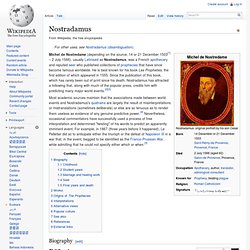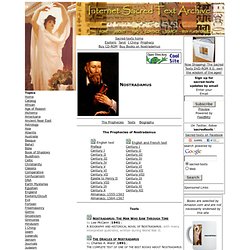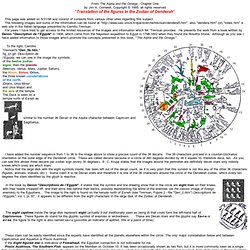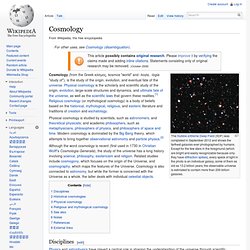

Chakra. From an 1899 Yoga manuscript in the Braj Bhasa language.

Their name derives from the Sanskrit word for "wheel" or "turning", but in the yogic context a better translation of the word is 'vortex or whirlpool'.[1][note 1] The concept of chakra features in tantric and yogic traditions of Hinduism and Buddhism. Etymology[edit] The word derives from Proto-Indo-European *kʷekʷlos, and its cognates include Greek kuklos, Lithuanian kaklas, Tocharian B kokale and English "wheel," as well as "circle. Bhattacharyya's review of Tantric history says that the word chakra is used to mean several different things in the Sanskrit sources:[3] "Circle," used in a variety of senses, symbolising endless rotation of shakti.A circle of people.
Nostradamus. Michel de Nostredame (depending on the source, 14 or 21 December 1503[1] – 2 July 1566), usually Latinised as Nostradamus, was a French apothecary and reputed seer who published collections of prophecies that have since become famous worldwide.

He is best known for his book Les Propheties, the first edition of which appeared in 1555. Since the publication of this book, which has rarely been out of print since his death, Nostradamus has attracted a following that, along with much of the popular press, credits him with predicting many major world events. Most academic sources maintain that the associations made between world events and Nostradamus's quatrains are largely the result of misinterpretations or mistranslations (sometimes deliberate) or else are so tenuous as to render them useless as evidence of any genuine predictive power.
Biography[edit] Childhood[edit] Student years[edit] Marriage and healing work[edit] Seer[edit] Century I, Quatrain 1: 1555 Lyon Bonhomme edition. Nostradamus Index. Sacred-texts home Esoteric Tarot I Ching ProphecyBuy CD-ROM Buy Books on Nostradamus The Prophecies Texts Biography The Prophecies of Nostradamus Biography of Nostradamus The renowned prophet Nostradamus (Michel de Nostradame) was born on December 14, 1503 in St.

Remy, Provence, France. During Nostradamus' lifetime the Black Death (today known as the bubonic plague) wiped out over a quarter of Europe. Nostradamus can indisputably be said to have been ahead of his time, at least in terms of medical practice. Translation of the figures in the Zodiac of Denderah. This page was added on 5/31/98 and consist of contents from various other sites regarding this subject.

The following images and some of the information can be found at " also "dendera.htm" (or) "index.htm" a web site in the Italian language presented by Camillo Trevisan. For years I have tried to get access to the limited resources of the images and information which Mr. Trevisan provides. He presents the work from a book written by Denon "Description de l’Egypte" in 1908, which came from the Napoleon expedition to Egypt in 1798-1802 when they found the Rosetta Stone. Dendera_zodiac2.jpg (JPEG Image, 896x894 pixels) Soteriology. Soteriology (Greek: σωτηρία sōtēria "salvation" from σωτήρ sōtēr "savior, preserver" + λόγος logos "study" or "word"[1]) is the study of religious doctrines of salvation.

Salvation theory occupies a place of special significance and importance in many religions. In the academic field of religious studies, soteriology is understood by scholars as representing a key theme in a number of different religions and is often studied in a comparative context; that is, comparing various ideas about what salvation is and how it is obtained. Buddhism[edit] Buddhism is devoted primarily to liberation from suffering, ignorance, and rebirth. Eschatology. Eschatology.

Cosmology. The Hubble eXtreme Deep Field (XDF) was completed in September 2012 and shows the farthest galaxies ever photographed by humans.

Except for the few stars in the foreground (which are bright and easily recognizable because only they have diffraction spikes), every speck of light in the photo is an individual galaxy, some of them as old as 13.2 billion years; the observable universe is estimated to contain more than 200 billion galaxies. Cosmology (from the Greek κόσμος, kosmos "world" and -λογία, -logia "study of"), is the study of the origin, evolution, and eventual fate of the universe. Physical cosmology is the scholarly and scientific study of the origin, evolution, large-scale structures and dynamics, and ultimate fate of the universe, as well as the scientific laws that govern these realities.[1] Religious cosmology (or mythological cosmology) is a body of beliefs based on the historical, mythological, religious, and esoteric literature and traditions of creation and eschatology.
Cosmogony. Cosmogony (or cosmogeny) is any model concerning the coming-into-existence (i.e. origin) of either the cosmos (i.e. universe), or the so-called reality of sentient beings.[1][2] Developing a complete theoretical model has implications in both the philosophy of science and epistemology.
